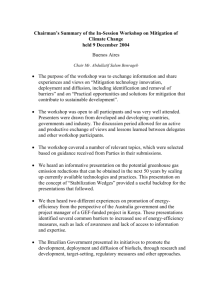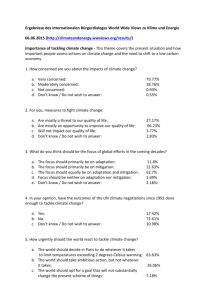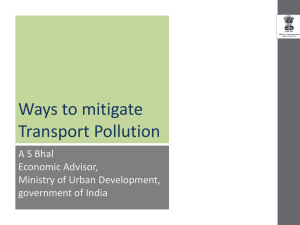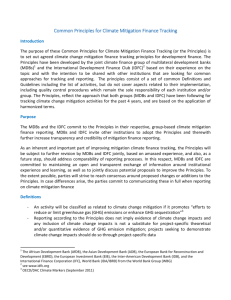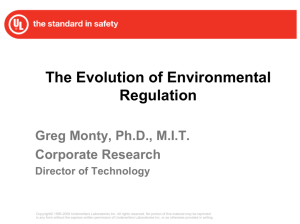Development of South Africa`s Climate Change Mitigation System to
advertisement
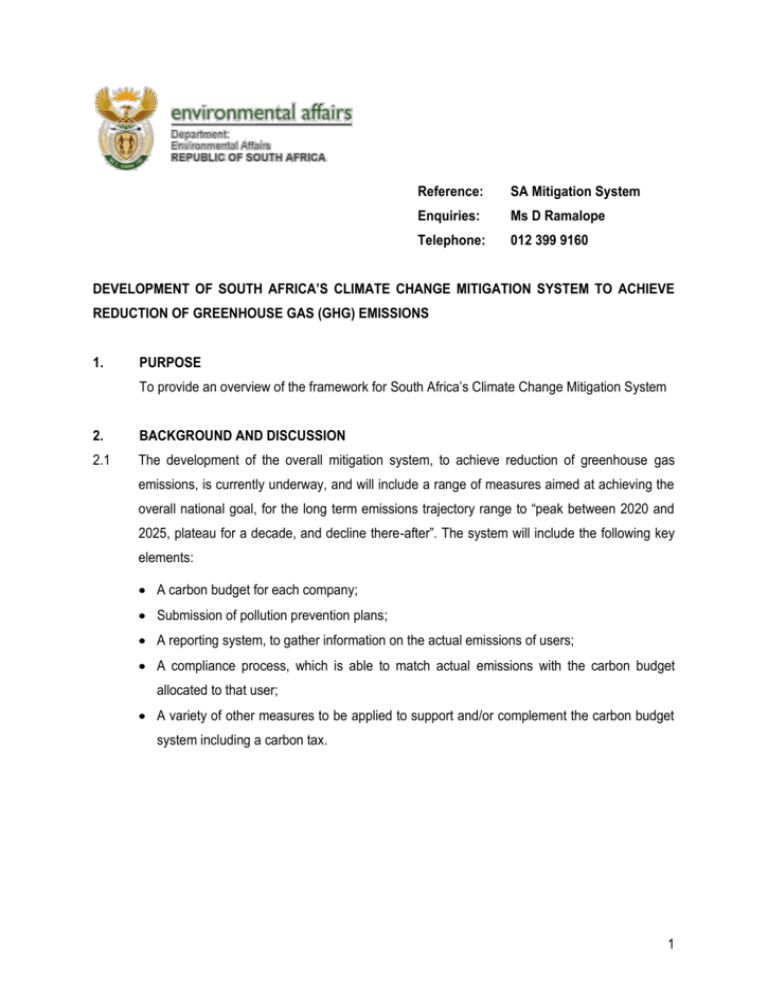
Reference: SA Mitigation System Enquiries: Ms D Ramalope Telephone: 012 399 9160 DEVELOPMENT OF SOUTH AFRICA’S CLIMATE CHANGE MITIGATION SYSTEM TO ACHIEVE REDUCTION OF GREENHOUSE GAS (GHG) EMISSIONS 1. PURPOSE To provide an overview of the framework for South Africa’s Climate Change Mitigation System 2. BACKGROUND AND DISCUSSION 2.1 The development of the overall mitigation system, to achieve reduction of greenhouse gas emissions, is currently underway, and will include a range of measures aimed at achieving the overall national goal, for the long term emissions trajectory range to “peak between 2020 and 2025, plateau for a decade, and decline there-after”. The system will include the following key elements: A carbon budget for each company; Submission of pollution prevention plans; A reporting system, to gather information on the actual emissions of users; A compliance process, which is able to match actual emissions with the carbon budget allocated to that user; A variety of other measures to be applied to support and/or complement the carbon budget system including a carbon tax. 1 2.2 Carbon budgets 2.2.1 Carbon Budget is a Greenhouse Gas (GHG) emissions allowance, against which direct emissions arising from the operations of a company, during a defined time period will be accounted. The term “carbon” in carbon budget is shorthand for carbon dioxide, and further, for all GHGs accounted for in the latest South African inventory (2010), i.e. carbon dioxide, methane, nitrous oxide, sulphur hexafluoride and the hydrofluorocarbons (hfc) and perflurocarbons (pfc) families of gases currently reported in the national inventory. 2.2.2 The Carbon Budget System will be introduced in two phases – an initial phase (2016 to 2020), during which a detailed legal basis will be established for the second and subsequent phases (2021-2025; 2026-onwards), and reporting and compliance systems will be established. Compliance requirements during the first phase will therefore be very limited, and carbon budgets will be included in pollution prevention plans. 2.2.3 Selection of Budget Companies Participating in Phase 1: at present, there is no legal basis for the selection of companies to participate in the carbon budget system. Companies participating in Phase 1 have been identified through a set of criteria that have been consulted with stakeholders. 2.3 Pollution Prevention Plans Draft National Pollution Prevention Plans Regulations have been developed under the National Environmental Management: Air Quality Act, 2004 (Act No. 39 of 2004), and are currently being reviewed by the legal team. The purpose of these regulations is to prescribe the submission and implementation of pollution prevention plans by companies allocated carbon budgets. The implementation of plans will demonstrate progress towards achievement of the carbon budgets allocated to these companies. 2.4 Greenhouse Gas Reporting Draft National Greenhouse Gas Reporting Regulations have been developed under sections 12(b) and (c) and 53(aA), (o) and (p) read with section 57 of the National Environmental Management: Air Quality Act, 2004 (Act No. 39 of 2004). They have been published for public comment. The main objective of these regulations is to introduce a single national reporting framework for the reporting and dissemination of information related to GHG emissions in order: 2 to enable the collection, collation and publishing of GHG emissions data and information in an effective and efficient manner, for South Africa to meet its obligations on international reporting requirements under the United Framework Convention on Climate Change and other international programmes, to fulfil section 6.7 of the National Climate Change Response Policy that requires GHG emissions inventories that are accurate, compete and up-to-date, 2.5 to inform the formulation of national policy and strategy on greenhouse gas reduction. Alignment between carbon budgets and the carbon tax The National Treasury and the Department of Environmental Affairs have examined various options for the alignment of the carbon tax and the carbon budget (CB) system, and have now identified a suitable approach. 2.6 The proposed approach to recognize carbon budgets makes provision for an additional 5% allowance to companies participating in phase 1 (2016-2020) of the carbon budget system. A company may only receive the additional allowance if has been awarded a carbon budget. 2.7 Desired Emissions Reduction Outcomes (DEROs) Following several consultation meetings with stakeholders on the desired emission reduction outcomes (DEROs), the department has revised the methodology for the allocation of DEROs to different sectors, and the draft document is being consulted internally and will be released for stakeholder consultation in August 2015. 2.8 Greenhouse Gas Mitigation Technology Implementation Plan (DST-led) The DST and DEA jointly developed the Mitigation technology implementation plan. The objective of the plan is to better understand what is required to support the implementation of climate change mitigation technologies in South Africa. The plan provides steps to be taken to further promote the identified technologies and establishes the basis for the development of roll-out plan of each of the identified technologies. The plan will be presented to Cabinet in September/October 2015 for approval. 3
